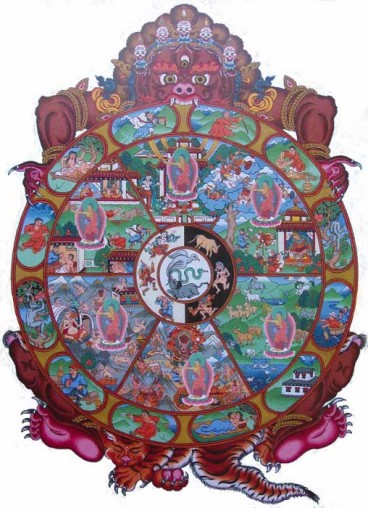[Translated from the Pali by Thanissaro Bhikkhu.] Staying at Savatthi. Then a brahman cosmologist went to the Blessed One and, on arrival, exchanged courteous greetings with him. After an exchange of friendly greetings & courtesies, he sat to one side. As he was sitting there, he said to the Blessed One, “Now, then, Master Gotama,… Read More »
[Translated from the Pali by Thanissaro Bhikkhu.] I have heard that on one occasion the Blessed One was staying near Kosambi, at Ghosita’s monastery. Then in the early morning, having put on his robes and carrying his bowl and outer robe, he went into Kosambi for alms. Having gone for alms in Kosambi, after the meal, returning… Read More »
The Great Causes Discourse Note: This discourse of the Buddha is one of the most important discourses in the Pali Canon. The Buddha also explained this teaching visually through the painting of the Wheel of Life. The elements of dependent origination (co-arising) are shown around the outside of the wheel as they appear to us. This was and is… Read More »
The following are the main collections of Suttas from the Pali Canon and followed by the Theravada tradition. The Agama Section (Volumes 1-2) of the Chinese Canon contains 151 texts that correspond to the Pali Canon, but were translated from the Sanskrit of the Sarvastivada tradition. Agama means “those handed down by tradition.” Selected translations, often in a… Read More »
The following twelve links of dependent origination are the Buddha’s explanation of the process by which beings live, die, and are reborn again: 1. Ignorance: This is the sower of the seed—being ignorant of the Law of Cause and Effect and being ignorant of the mode of existence of things. It is usually illustrated with… Read More »
This is a preliminary effort to show the contents of the three major collections. Although this may not be complete, it does provide an idea of what these three collections include. THE VINAYA The Pali Canon The Chinese Canon The Tibetan Canon VINAYA PITAKA XII.Vinaya Section (Volumes 22-24) VINAYA (Volumes 1-13) A. Suttavibhanga: Patimokkha-Monastic code… Read More »

